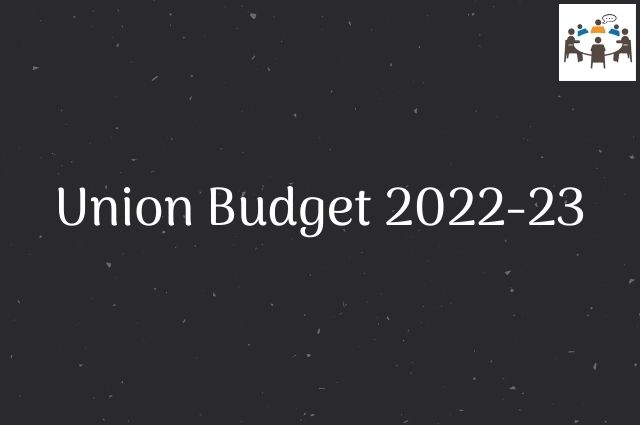Theme:
- On 1st February 2022, Finance Minister Nirmala Sitharaman presented Union Budget 2022-23 in the parliament.
Union Budget 2022-23 Analysis:
Education:
- During the pandemic, we realized the importance of online education. This budget proposed the setting up of a digital university named “DESH-Stack portal” in collaboration with universities. This is a very good step considering the negative impact of the pandemic on offline education.
- Budget 2022 proposed setting up 200 TV channels under the e-Vidya program for the students of classes 1-12. At present, there are 12 TV channels.
- To improve the quality of education available for students, quality e-content will be created in regional languages.
- World-class foreign universities will be allowed to set up educational institutions for financial management, fintech, science, technology, engineering and mathematics courses in Gujarat’s GIFT city. They will be free from domestic regulations. This move has the potential to increase the number of skilled manpower in the technology and financial services sectors.
- As schools are reopening, Budget 2022 increased the budget for the Samagra Shiksha scheme by 20% to help schools.
- But the budget did not do enough to solve the problem of lack of infrastructure and staff shortage. As the schools are reopening, and many children could not even attend online classes, there is a need to put extra effort into teaching students and it is very important to improve the infrastructure in schools. Moreover, many children dropped out of school and several girls were forced into child marriages. So, there is a need to take steps to bring them back to schools.
Employment opportunities:
- An increase in capital investment from 1.3% of GDP to 2.9% to fund various infrastructure projects in 2022-23 has the potential to create plenty of jobs.
- Under PM Awas Yojana, Rs. 48,000 was allotted to boost affordable housing. Moreover, it also allocated ₹60,000 crores to extend tapped water coverage to 38 million households in 2022-23. This too has the potential to create many jobs.
- In the budget 2022 speech, the Finance minister announced that the PLI scheme in 14 sectors can create 60 lakh new jobs over the next 5 years. As per the data of ‘Centre for Monitoring Indian Economy (CMIE)’, India’s unemployment rate is 6.57% as of January 2022 and there were 5 crores 30 lakh unemployed people in December 2021. Moreover, every year 50 lakh young people join the workforce looking for work. So, the jobs that can be created will not be enough to solve the unemployment issue.
- Pandemic made many people jobless. Last year, MGNREGA (Mahatma Gandhi National Rural Employment Guarantee Scheme), which provides at least 100 days of guaranteed wage employment in rural areas can help many people to feed their families. Many economists opined that a similar scheme in urban areas is essential to help the urban people, who lost jobs due to the pandemic. But the budget for 2022 cut the expenditure on MGNREGA by 25% to 73 lakh crore rupees.
Agriculture:
- Rs. 1,24,000 crore was allocated in budget 2022 for the agricultural ministry, which is a 2% increase from the last year’s budget.
- Rs. 44,000 crores were allocated for the Ken-Betwa river linking project. The finance minister mentioned that this project will benefit 9 lakh farmers.
- It was also announced that Kisan drones will be promoted for crop assessment and spraying of pesticides. Integrating technology into agriculture can improve productivity.
- A NABARD-funded program will be set up to support Agri startups.
- Approximately, 58% of the working population of India is in the Agricultural sector. Moreover, there is disguised unemployment in the agricultural sector (which means there are more workers than required). So, promoting drones that can replace agricultural labourers may not be a good move, especially at this time when the pandemic has already made many people jobless.
- The target of doubling the farmers’ income by 2022, which was set in Budget 2017-18, was not mentioned in this year’s budget speech. So, there is no clarity on whether the government will work on this target or not.
Health sector:
- This pandemic has caused several mental health issues in many people including children due to uncertainty, isolation, stress etc. So, the budget 2022-23 announced the National Tele Mental Health program. This is a very good step.
- But there is a need to improve primary healthcare services throughout the country and especially in rural areas. There is also a need to address the lack of human resources in the healthcare industry. These things are important especially during this pandemic, but the budget did not address these issues.
Economy:
- Under PM Gati shakti master plan, the National Highway network will be expanded by 25,000km roads. The government is planning to set up multimodal logistic parks at four locations. These steps can boost economic activity.
- An increase in capital investment from 1.3% of GDP to 2.9% to fund various infrastructure projects in 2022-23 helps the economy.
- The Finance minister announced a 1 lakh crore rupees loan facility to states without interest. This is an opportunity for states to invest in projects to improve the economy.
- Due to the pandemic, consumer spending has decreased to a great extent, which caused an economic slowdown. So, tax relief for the salaried middle class and cash handouts to poor people would have increased consumer spending.
Conclusion:
Union Budget 2022-23 gave a push to infrastructure to improve the economy. But it didn’t do enough to solve the immediate crisis of huge unemployment and increased poverty caused by the pandemic.
Your Turn…
What are your thoughts on Union Budget 2022-23? Express your point of view through the comment section below. And subscribe to our blog to read answers to the trending GD topics.
References:
Copyright @ Group Discussion Ideas.

